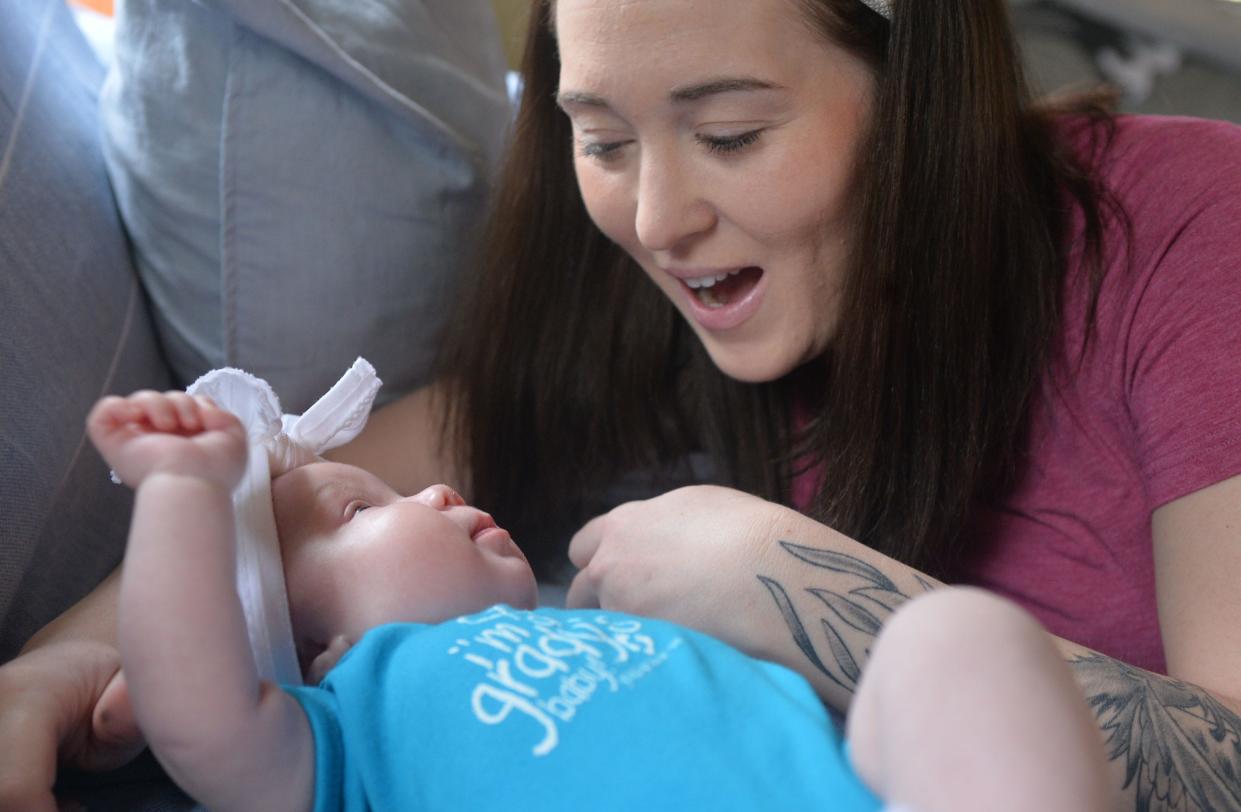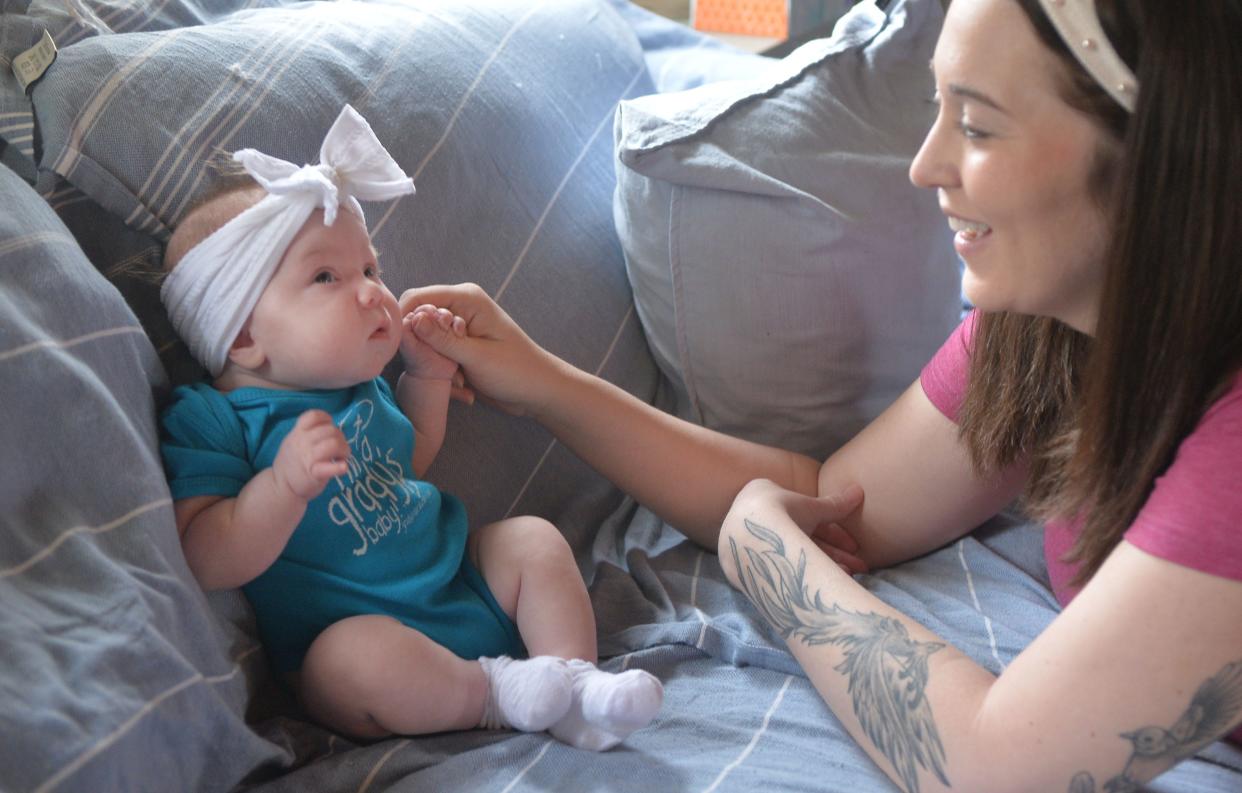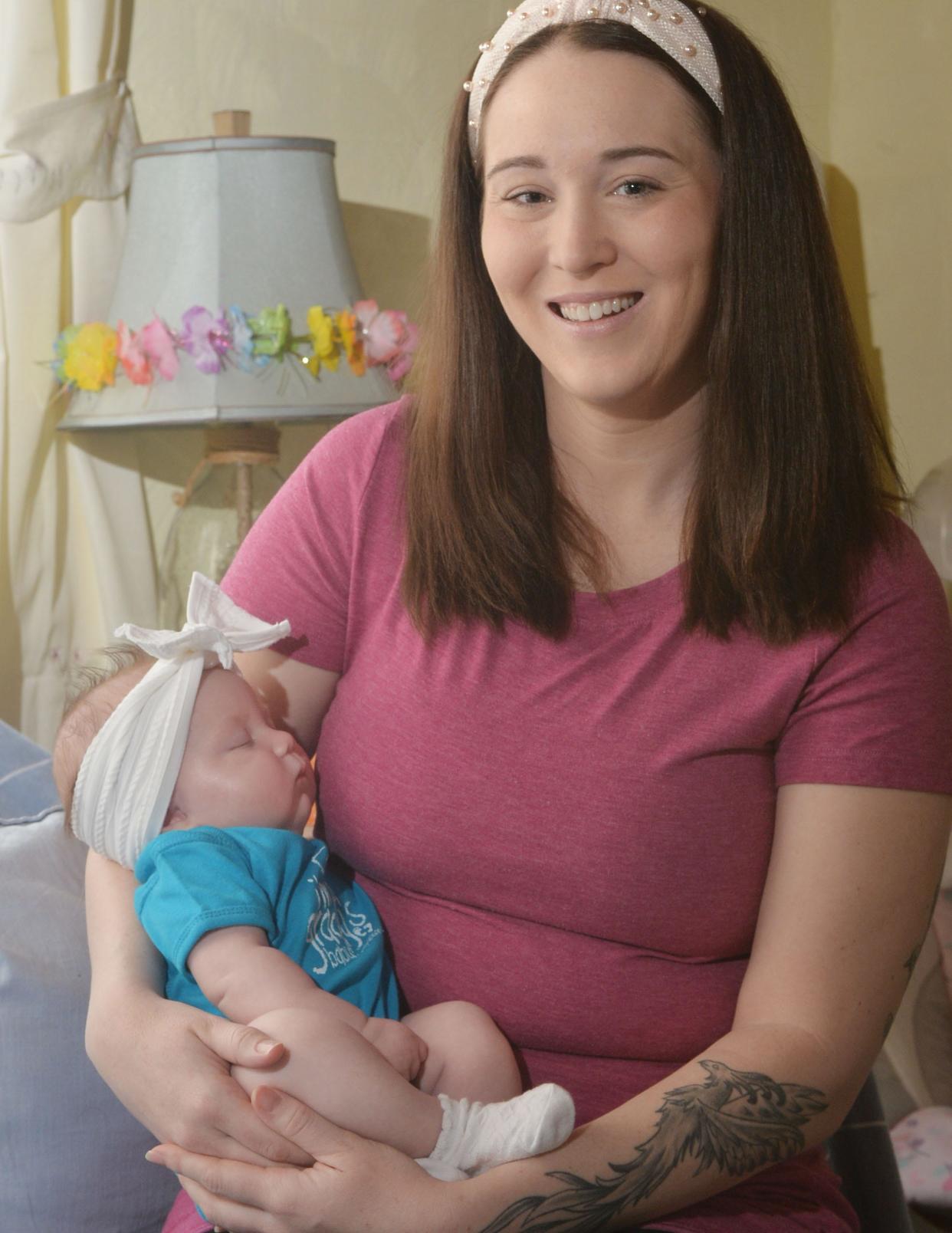'Am I dying?': Erie doctors, nurses battle to save mother and baby during childbirth crisis
Maria Hodapp and Brandon Edwards had just watched a team of doctors and nurses bring their newborn baby, Lorelai, back to life and whisk her out of Hodapp's labor & delivery room at UPMC's Magee Women's Hospital in Erie.
But Lorelai wasn't the only one in danger. What was expected to be a routine childbirth had suddenly become a life-threatening crisis for both mother and daughter.
Hodapp, 33, looked at the nurses who held each of her hands and noticed that their faces were getting blurry. She was losing blood, a lot of it, and obstetrician-gynecologist Dr. Tim Weibel was fighting to stop the flow.
"I looked at Brandon and he was as white as a ghost with his mouth wide open," Hodapp said. "I asked him, 'Am I dying?'"
Nothing during Hodapp's pregnancy had given Weibel any indication of a high-risk delivery, let alone two separate medical problems that nearly killed Hodapp and Lorelai.

Hodapp was scheduled to have her labor induced March 1, but her water broke a day earlier on the morning of Leap Day. Edwards, Lorelai's father, drove Hodapp to Magee-Women's from their home in North East Township.
The first sign that anything was unusual was when Hodapp was given an epidural injection to reduce the pain of delivery. She bled enough to turn a towel red and cause the anesthesiologist to use the medical version of Super Glue to close the injection site, Edwards said.
"But that was hours before delivery," Edwards said. "Everything else seemed fine."
The real problems began when Lorelai's shoulder became stuck behind Hodapp's pubic bone. It's called shoulder dystocia and is an unpredictable complication that occurs in about 5% to 9% of vaginal deliveries of babies who weigh more than 8 pounds, 13 ounces, according to the Cleveland Clinic.
Lorelai was born weighing 9 pounds, 5 ounces, Hodapp said.
"What you have to do is reach the baby, rotate its shoulder and bring the shoulder under the pubic bone," Weibel said. "Some of them are easier to do than others. This was a particularly difficult one."
A race against time to save Lorelai
Weibel also was in a race against time. Lorelai was unable to breathe while in the birth canal and her umbilical cord, through which she received oxygen from Hodapp, was constricted.
Babies can last about 10 minutes without oxygen before suffering irreversible brain damage or death.
A nurse in the room pressed an alarm, sending an emergency code to the neonatal intensive care unit. Within seconds, another team of doctors and nurses entered Hodapp's room.
Weibel was able to dislodge Lorelai's shoulder and deliver the baby. By the time he was able to extricate her, Lorelai was not breathing and barely had a heartbeat.
"She looked dead. She was gray," said Carolyn Mariotti, R.N., a neonatal intensive care unit nurse at Magee-Women's. "Usually a baby comes out looking bluish-gray at first, and then they pink up. She did not."

The neonatal team showed Hodapp and Edwards their baby before moving Lorelai quickly to a newborn preparation table to start CPR.
Neonatologist Dr. Sean Frederick began rescue breathing, using a mask and bag to pump air into Loralei's tiny lungs, while a nurse practitioner started chest compressions on the newborn and counted "one, two, three — breathe!"
"When you perform CPR on a newborn, you place all of your fingers behind the baby's back and compress just with your two thumbs," Mariotti said.
After a couple of minutes that Mariotti said "seemed like forever," the team was able to get Lorelai's heart beating regularly and Frederick inserted a breathing tube down the newborn's throat.
Nothing could stop Hodapp's bleeding
As the neonatal team stabilized Loralei and wheeled her to the NICU, Weibel was busy trying to save Hodapp's life. She was bleeding so severely that at one point Edwards saw it spray onto Weibel's shirt.
"There was some trouble with clotting, whether she had an underlying disorder or what," Weibel said. "And when you start losing blood, you lose clotting ability. It's like the worse the bleeding gets, the worse the clotting gets."
Weibel tried massaging Hodapp's uterus, giving her clotting medications, suturing her incisions — nothing could stem the bleeding.
Hodapp said she was later told that she lost 3.5 liters of her body's five total liters of blood and needed 14 transfusions.
"Maria's blood pressure was plummeting, and I could tell Dr. Weibel was struggling to stop her bleeding," Edwards said. "He had this look on his face. It wasn't that he was defeated, but he was definitely frustrated."
One last option to save Hodapp's life
Faced with dwindling options, Weibel and the team decided to perform an emergency hysterectomy. Hodapp was wheeled into a nearby operating room.
As she was transported through the hallway, Weibel met quickly with Hodapp's mother, Barb Hodapp, for permission to perform the surgery. It meant the 33-year-old woman would never be able to have another baby.
"My mom asked him what would happen if he doesn't do the hysterectomy," Hodapp said. "He told my mom, 'I don't think she will make it.'"
Barb Hodapp gave her permission.

Hodapp, who was conscious at that point, didn't even know her mother was already at the hospital.
"I remember being wheeled into the hallway and asking for my mom, and she was right there," Hodapp said. "I didn't understand how she got there, because I was supposed to call her after the delivery so she could drive in from her home in Greene Township."
Edwards had called Barb Hodapp and told her to rush to Erie because there was an emergency.
'The hardest two hours of my life'
Meanwhile, Edwards was with Lorelai, who had been taken to the NICU. Because the newborn had been without oxygen for several minutes, the neonatal team wrapped her in a cooling blanket to lower her body temperature.
"Cooling the baby helps preserve brain function in these situations," Mariotti said. "You fill the blanket with cold water and keep the baby's body temperature at 33 degrees Celsius (91.4 degrees Fahrenheit) for 72 hours."
The cooling process started at the Erie hospital, but a medical helicopter soon transferred Lorelai to UPMC's Children's Hospital of Pittsburgh.
Edwards followed in his car.
"That drive down to Pittsburgh was the hardest two hours of my life," Edwards said. "I had no idea what was going on behind me and no idea what was going on in front of me."
After getting permission from Hodapp's mother, Weibel performed the emergency hysterectomy. Only by removing her uterus could Weibel stop the bleeding.
"It was our last option," Weibel said. "We couldn't stop it any other way."
Hodapp's bleeding due to undiagnosed clotting disorder
Hodapp woke up in the intensive care unit, unable to talk because doctors had inserted a breathing tube. She remained there for three days, recovering and learning more about what had happened.
Weibel had found that Hodapp's uterus hadn't ruptured and that there was nothing wrong with the placenta, two common causes for massive bleeding during childbirth. Her blood simply didn't clot.
"She had a clotting disorder, even though she had no history of it and no family history," Weibel said.
Weibel gave all the credit to the team of doctors and nurses who worked to save both lives.
"What happened wasn't very common at all, thank God," Weibel said.

The news about Lorelai was almost as surprising.
Diagnostic tests showed that the baby was doing remarkably well considering that she suffered a stroke-like injury to her brain during delivery and had gone into cardiac arrest due to a lack of oxygen.
"She was very sick to start but she has a good prognosis," Frederick said. "After she was cooled for 72 hours and then warmed up, she underwent neurological imaging and everything looked good."
'Like 300 pounds had been lifted off my back'
Lorelai eventually was transferred back to Erie, riding with Edwards in an ambulance to the Magee-Womens NICU.
"Maria was just crying, finally getting the chance to hold her baby," Edwards said. "I remember sitting down and it felt like 300 pounds had been lifted off my back."
Hodapp wasn't the only one thrilled to see Lorelai.
"When she came back to Hamot, I got to hold her for the first time," Mariotti said. "It was like holding my very own child. She looked amazing."
Lorelai was sent home April 5, six weeks after she was born. She has a feeding tube and is dealing with some developmental delays, but otherwise is a healthy baby girl.
Hodapp has recovered almost completely and is seeing a hematologist to find out more about her clotting disorder.
"I just can't say enough about Dr. Weibel and that whole team. They saved our lives," Hodapp said. "When I was in the ICU, Dr. Weibel came in and gave me a frog hat for Lorelai since she was a Leap Day baby. Then the NICU nurses told me he was in there seeing Lorelai almost every day."
Contact David Bruce at dbruce@timesnews.com. Follow him on X @ETNBruce.
This article originally appeared on Erie Times-News: UPMC Magee-Womens doctors, nurses save mother, baby during childbirth
